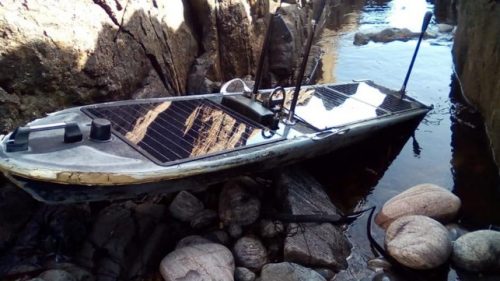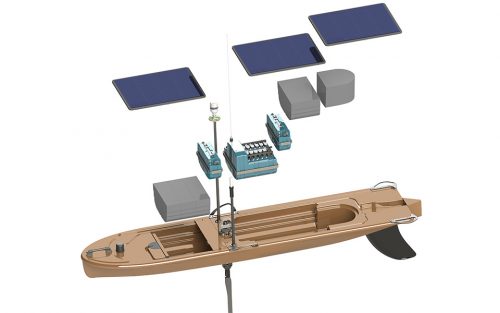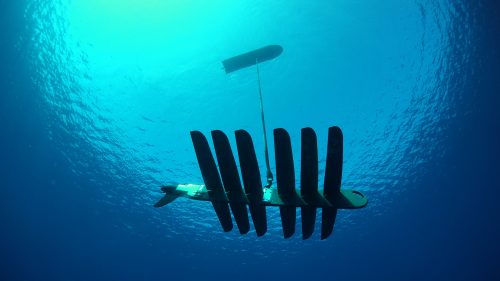A little more than three metres long, the craft looks like a surfboard with solar panels. It was identified as the surface element of a Wave Glider, an “unmanned surface vessel” made by California-based Liquid Robotics, part of Boeing Corp.’s defence, space and security division.
The new-generation vessels are described as autonomous boats which can stay at sea for up to a year and carry out missions 24/7, providing “seabed to space monitoring.”
“The team were called today to reports of an object in the water. Once on scene we secured the item,” HM Coastguard Rescue Team Isle Of Tiree said in a statement on Sept. 28. “We are currently trying to find out some more information as to the object’s origin and owner. If anyone has any information, please get in touch. Remember if you see something out of place on the coast please dial 999 and ask for the Coastguard.”
With an electronic suite powered by solar panels, the Wave Glider is propelled by a tethered submarine element that harvests energy from the movement of ocean waves. The vessel travels at up to two knots.
The submerged wing rack is equipped with a rudder for steering and a thruster for additional power during extreme conditions. It uses no fuel but it does risk running aground in shallower water.
Operating in dead silence, Wave Gliders typically carry payloads such as atmospheric and oceanographic sensors for ocean and climate science, seismic sensors for earthquake and tsunami detection, and video cameras and acoustic sensors for security and marine environment protection.
The vessel travels at up to two knots.
Wave Gliders “help scientists, businesses, and governments gain new insights and improve decision making,” Boeing says on its website. “Operating at the surface, these autonomous surface vehicles provide the essential link between sea, air, and space. They expand how we collect metocean and marine data, bridging a data and access gap previously inaccessible, and can transform subsea sensors into real-time information sources.”
Since 2007, Wave Gliders have been deployed from the Arctic Ocean to the Southern Ocean. They have tracked great white sharks, patrolled Britain’s marine protected areas and assessed the health of Australia’s Great Barrier Reef.
The biggest users of Wave Gliders, however, are the military.

Boeing says the crafts are ideal in anti-submarine warfare, intelligence, surveillance and reconnaissance, as well as other military applications. It also cites potential roles in protecting maritime borders, monitoring marine protected areas, and combatting illegal fishing, trafficking and smuggling.
“Over 1.5 million nautical miles travelled to date with operations through doldrums and hurricanes/typhoons,” boasts Boeing. “Guinness World Record for crossing the Pacific Ocean and achieving ‘the longest journey of an autonomous unmanned surface vehicle on the planet.’”
That 2013 trip covered more than 14,000 kilometres, from San Francisco to Australia, meaning the one discovered in Scotland could have originated virtually anywhere.
In 2017, Liquid Robotics announced the “Next Generation Wave Glider,” with advancements to the platform’s operational range, and performance for missions in high sea states and high latitudes. They are worth US$250,000-$300,000, without the bells and whistles.
Unusual features about this particular Wave Glider that suggest a military rather than scientific mission.
At the Unmanned Warrior 2016 Exercise in the United Kingdom, the Wave Glider became the first autonomous surface vehicle to detect a manned diesel submarine. The exercise bills itself as “a showcase of autonomous robotic systems that perform a dazzling array of air, surface and sub-surface tasking.”
The Isle of Tiree is about 160 kilometres from HMNB Clyde, the operating base for the UK’s fleet of nuclear submarines, including the Vanguard class, which carry Britain’s Trident nuclear deterrent, as well as the nuclear-powered Astute and Trafalgar hunter-killer classes, Forbes reported.
“The glider may have been involved in an exercise to see whether these subs could be detected leaving the base,” wrote David Hambling, the magazine’s aerospace and defence writer. “As an outside possibility, the Russian Navy developed a near-clone of the Wave Glider called Fugu in 2016…. If this one is Russian, it might explain why it has not been claimed.”

“Without these aids, the glider, which lies flat on the water, would be extremely difficult to spot,” said Hambling. “This would make it a navigation hazard, though in almost any collision the small unmanned craft would probably come off worse.
“This may explain why one of the antennas is broken and how it ended washed up on a beach. The question though is why such a vessel would be sailing covertly in ‘stealth mode.’”
The British military has denied the vessel is theirs, as has the UK Centre for Environment, Fisheries and Aquaculture Science. The only other publicly acknowledged operator is the U.S. Navy.
Advertisement













